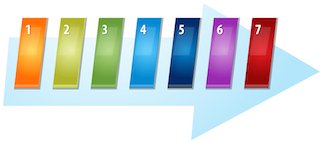In today’s article, we’re going to talk about easy and actionable ways in which you can measurably increase your final expense sales activity.
The following tips are all designed to hit on things that many agents don’t do but should. They serve as a reminder of things that you can do and continue to do to increase your sales, but also as a tool for the agents who are relatively new and are looking for the big picture stuff to change up in order to see a measurable increase in results and sales.
I believe in the Pareto Principle and how it applies to everything in life. If you’re not familiar with the Pareto Principle, it means that 80% of your results come from 20% of your actions. Identifying one or two of the items in this article, and implementing them on a large-scale basis can have an immediate impact on your income and sales results.
So let’s get started and go into detail on the 7 tips to increase final expense sales activity:
Tip #1: Find ways to shift your final expense sales from telemarketing leads to direct mail leads
This tip is specific to those agents utilizing final expense telemarketing leads or avatar leads or any sort of non-direct mail, over the phone-type of lead. My experience is that the top 10% of all final expense agents produce the majority of their business through a consistent effort at marketing with direct mail final expense leads. Whereas avatar leads, while some agents do very well with them, they still are in the minority.
So why are direct mail leads a simple and easy way to increase your sales? Here’s a couple of reasons. First, direct mail leads tend to attract more consistent level of buyers than telemarketing leads. Why is this the case? I’m not sure, but usually the reason lies in the fact that people who fill out direct mail leads are more intentional with the reason that they do so. Telemarketing catches people off guard, are not as engaged relative to direct mail, and easily forget the call because many people receiving telemarketing leads receive multiple telemarketing calls for all sorts of things every single day. Direct mail, with its higher engagement level, tends to generate more buyers.
Second, there’s a huge efficiency difference in working these leads. Unless you live in a major metropolitan area, direct mail allows for the medium town, small town and rural area a lot more appointment-setting and appointment-running efficiency versus any kind of telemarketing lead variant. This is due to the “Do Not Call” list, which has eliminated approximately 80% of the callable data that we have, along with the widespread move away from home phones to cell phones, which are prohibited to call from anyway.
What this all amounts to is an increased requirement in data to call upon to generate leads, versus what you can get from direct mail. If you ask any agent working telemarketing leads in a rural capacity, you’ll find that many times they are 30 minutes to an hour between appointments. However, if you have direct mail and your appointments are 15 to 20 minutes apart, it’s going to be a lot easier to set more appointments per day, as well as door knock in between appointments in a more efficient manner. You can see more people via this method for the vast majority of agents through switching to direct mail and thus have more opportunity for sales.
Tip #2: Ask the tough questions up front
This tip pertains to the process of selling the people that you talk to, and figuring out whether or not they’re a qualified prospect versus an unqualified suspect.
Let me discuss the difference between a suspect and a prospect. A suspect is somebody who is suspected to have interest in what you’re selling, but doesn’t completely meet the criteria of a buyer. A prospect is somebody who has need, urgency, budget, a bank account, and trusts me. If the lead meets all five criteria, he is a qualified prospect and most likely will buy.
Notice above that I defined a suspect as someone who doesn’t completely meet all the buying criteria. A suspect can meet all but one specific criteria. Meaning he can be passionately desirous of life insurance and still not qualify because he has no bank account to set up auto-deduction drafts. And the takeaway is no matter how hard you sell these people to buy, with even one criteria missing, the lead isn’t going to buy from you because he’s not qualified! There’s nothing worse than to try to sell a suspect because the agent did not properly vet them from the beginning.
How do you ask the tough questions up front? You first need to determine what questions need to be ask to determine if someone is a buyer or not. For me, what I need to know in order to make a deal happen is:
1) Does this person have an account to draft?
2) Does this person 100% have the ability to pay for a policy as long as it stays below a specific price?
3) Does this person have an urgent, emotional reason to NEED and WANT the coverage?
4) Does this person’s health allow them to qualify?
My goal as an agent is to politely and diplomatically ask these questions early on in the sales call. And the quicker I ascertain this information, I will, A) determine whether or not the lead has a high chance of buying while continuing the sales process, or B) determine if the lead is a low-odds close, then pack up and leave within the first 15 to 20 minutes.
I had a sales call where I met with a couple, both of which had insurance for 10 years. Both were paying about twenty bucks a month on a $10,000 plan. I started my sales presentation first by asking for what reason they sent in the card? Both admitted curiosity and informed me they had additional life insurance through their employer.
From personal experience, these deals are the toughest to sell. They have enough to bury them and additional coverage at work. Urgency levels with these prospects are very low, and this sales call was turning out to be no different. So I flat-out asked them, “If worst-case scenario you lose your coverage at work, and all you have are the $10,000 plans, how much need do you have today for any kind of coverage? And if its X amount of dollars per month, does that make sense for you to review any further?” They were quite happy with what they had. And therefore were only marginally interested in seeing what else was out there.
The point I’m making is information like this ALWAYS should be determined as quickly as possible, preferably within the first 15 minutes of the sales call. Sure, it’s tough to question the lead as to why he needs insurance, or even second-guess him as to why he needs more. These are all uncomfortable questions to ask as many sales people want to pitch blind without regard to the underlying factors, thinking their pitch is going to change hearts and minds. They want to just get right in and steamroll the lead into a deal! But the smart method is to cut your time losses on the low-odds opportunities, and invest your time on the high-odds qualified prospects, otherwise known as your buyers!
The best salesmen are deliberative and consultative in nature. They ask the tough questions right away. And they figure out as quickly and as politely as possible if the person across the table from them is a buyer or a pretender.
So start asking the tough questions! Ask why they sent the card in. Ask who they have their coverage with. Ask for what reasons they want more if they have current coverage. Dig into what they want their policy to do for them. Feel comfortable asking for a budget range commitment. These questions will draw out valuable and useful information, and give you the ammo to make the sale. There’s nothing more convincing to the prospect saying out loud the thoughts he has kept inside his head. There is something powerful when the prospect says out loud, “I need to get life insurance. This is something I’ve been thinking about and I know I need it.” That’s the most convincing words that any buyer will hear!
By asking the tough questions and eliciting the lead’s feelings about buying life insurance, ultimately it’s a very powerful way to sell because buying becomes the lead’s idea (not yours). And all we do as salesmen is bring out that idea and show them how it can easily become a reality. So ask the tough questions! It makes ALL the difference in making the sale.
• Comments or tips of your own to add? Please visit this new thread:
7 tips to increase final expense sales results – new article from David Duford
Tip #3: Aggressively review the lead’s policies
This is a sure-fire way to make more sales immediately. Always review the policies if there’s any existing insurance in force, even if you’re not sure if it’ll make a difference or not.
Reviewing a policy allows you to figure out if there’s an edge you can gain in making a sale. Agents who are independent make a lot more sales simply because of replacing inferior coverage. Luckily we exist in a world where there’s a lot of desperate agents who would rather cut corners on making sales than doing the right job on the front end!
So what are the benefits of doing a policy review? By reviewing a policy, you gain an edge over your competition. When you can ask for the policy, take time after reviewing it to show and educate the client exactly what the policy does. By doing this, you’re going to do more than 99% of the agents out there which gains the prospect’s respect and trust. And when you review a policy, it gives you the most crucial element to making sales where there otherwise would be no sale to exist. Policy reviews give you an edge to persuade and build tension within the prospect to buy from you to right what is wrong with his existing policy.
I sold a policy about a year and a half ago to a couple of Spanish-speaking individuals. They spoke broken English, and had to depend on their kids who spoke and understood English better to help them make purchase decisions. When I met with them and their daughter, I asked to do a policy review. They had a policy through State Farm, and were told the policy would not cancel because it was whole life insurance.
After asking the price and the amount of coverage, I realized based on the pricing, there’s no way that this could be whole life if the policy was taken 10 years ago. So we pulled the policy out, reviewed it, and sure enough, it was a 10-year term insurance plan that State Farm had sold them. I showed the wife in the fine print of the policy where the 10-year point was in the contract and how a premium increase would occur in the tenth year. This information was never shared with her by her State Farm representative. And sadly, the wife flat-out began to cry. She was so upset that she had been taken advantage of by someone she trusted.
Through additional fact-finding and asking the tough questions up front, I found out she was very interested in a paid-up policy. So I educated and showed her how a paid-up policy was a bargain for her because she would pay less in the face amount and she would reach a period of time in which she wouldn’t pay any more into it. This was a huge advantage to her and she liked it very much. I ended up selling both her and her husband.
So that’s what a policy review can do. Remember to always be sober about how others perceive you. Sorry to say, but you are a salesman, and society holds you guilty until proven innocent! So you must take steps to fight back against this perception, and showing versus telling always beats back initial skepticism. By showing instead of just telling, you will have created a level of endearment and trust in the prospect. And if what is presented to them is made obvious as to being a disadvantage, they will buy from you and potentially can the other plan. That’s why policy reviews are a great way to measurably increase your sales, and to get more results while you’re in the field, where otherwise you wouldn’t.
Tip #4: Go Independent, NOT Captive!
This is something I harp on in many of my videos. The way to have more financial success… the way to have more sales… the way to have a higher income is to be an independent agent offering a multitude of carriers instead of being a captive agent and married to just one. For currently captive agents, it is extremely important for them to understand that the grass ISgreener on the other side. In fact, it’s fully fertilized, world-class grass!
Independence as a final expense agent allows you to operate in a much more successful fashion. As a captive agent selling over-priced premiums, you’re not going to be in front of clients in which you can improve their life insurance situation measurably. If you work for the captive carriers, you have to rely on silly sales gimmicks to justify your high prices. Coupled with the fact that premiums are higher, you’re going to get replaced more often when agents who are independent run across your work several months later. Then you’re in a charge-back situation. You have to pay that debt back. And it’s going to be a much harder and longer struggle.
Captive agents, by simply going independent, will usually increase their final expense commissions to the tune of 10-20%. Sometimes that number is even higher! Quality of business ratios like persistency will rise by the same amount. Newly independent agents will now sell more of their leads. Closing ratios will increase. And all of this coupled together has an exponential effect upon an agent’s net income.
I did a video recently where I showed captive agents how switching to independence was a financially superior move. I demonstrated mathematically to a very highly successful captive agent how he could make an additional $100,000 more a year… without changing his sales presentation process, and only by offering different final expense carriers. I also explained how even small incremental increases in his closing ratio, his persistency and his income can have a measurable increase in his overall sales results.
So captive agents, take time to investigate the shortcomings of your situation and how independence is really the biggest solution to dramatically improve the results of your hard work!
• Comments or tips of your own to add? Please visit this new thread:
7 tips to increase final expense sales results – new article from David Duford
Tip #5: Trial close the critical steps of the sales call
I love trial closes! A trial close is a soft close in which you determine if somebody is on board with the concept that you’re selling at that particular moment in time. A trial close lets you see if the client understands what is being presented to them, and agrees with the direction things are going.
I use trial closes all the time in my sales closes. They’re subtle. The client doesn’t notice, and it allows me to apply a litmus test to see if this prospect is still qualified and on board with where things are going.
So how do you do a trial close and where do you do them? Well, the best place to do a trial close is when you’re selling the premium. Trial closes are usually offered on an “if/then” statement basis. For example, “If I can qualify you for a plan today, Mr. Jones, can you afford somewhere between $80 and $100 a month?”
If they say “yes” to this unequivocally, I know I’ve got a prospect. If they say anything otherwise, then I know they can’t afford it. I’m going to walk back my premium request in order to ascertain if this guy is a qualified prospect.
You can use trial closes at the beginning of the sales call in the pre-qualification phase. You can ask them, “Look, if I can find you can affordable plan, would it make sense for you to take it out if we can meet your budget?” Or, “If I can show you a plan that is definitely better than anything else that you see on TV or get in the mail, and we can find it and fit in into your budget, would that be something you’d like to get?” These are non-pressured questions to ask. They’re very simple to ask. They’re an honest, straightforward way to determine if somebody is on board with the sales process.
And what’s great about trial closes is they tell you right away if somebody is sincere in their interest and engaged, or if they’re just jokesters, time-wasters, or tire-kickers. If you get a weasel reply like, “Well, I don’t know, it just depends. I don’t know,” then a lot of the time you’ll find out you’re dealing with somebody who just is a time-waster, and not sincerely interested in what you have to offer.
Trial closes in a way, are a pre-qualification question as you are asking the tough questions up front. Asking those questions like, “If I can do something for you on an affordable basis, would you buy?” is a tough question for most novice agents! Especially if you ask it within the first 10 to 15 minutes.
Many novice agents are pre-conditioned to think, “Oh, I can’t talk about that until they’re my friend, and I’ve talked about the fish on the wall, and I’ve asked them all these questions. I don’t want to make them mad by asking them to buy.” Look, that’s weasel-worm salesmanship! There’s nothing wrong with asking straightforward questions and getting to the point, especially if you frame yourself as somebody who is a straight shooter. They’ll understand you a lot better once they understand that you’re somebody who gets to the point and respects their time.
Trial close all the time! Trial close on premium. Trial close on need. Trial close on concept when you present the different options and ask what they want. Do that often and frequently and you’ll find that you keep people on board, more engaged, and which will result in more buyers.
Tip #6: Magnetic business cards
This is the one tip I didn’t take until about a year ago. I’m kicking myself in the rear end for not doing it any earlier!
To TRULY understand final expense, you must understand the people we sell to. There’s as much of a mentality in final expense as there is a product type. Here’s what I mean. The final expense marketplace consists of what one agent penned as “largely irresponsible people” who have shafted their duty of protecting their family their entire lives… until the unfortunate and tragic accident of losing a loved one forced them into reality of the mortality of their lives. And when we show up, we’re usually selling people who are within that window of opportunity, where they see it making sense and they understand the need for final expense, and we go in and sell them on why we’re the best option.
Understand I’m not judging our prospects as this is what Napoleon Hill called “accurate thinking,” but we have to understand how final expense prospects truly are, not as we’d like them to be or idealize them as. These people typically live in low-income situations. They’re not the neatest. And they don’t have great organizational skills. This is a tangential factor to the fact they wait forever to buy insurance.
And when you hand them paperwork, usually it gets shuffled under a big pile of crap or, worst case, it ends up in the trash. A lot of final expense prospects AND clients whom are given business cards go straight into the trash upon receipt.
So how do you get around this? The magnetic business card is a most ingenious invention to keep your name in front of people whenever they experience the need again to buy insurance or possibly even refer. All you have to do when you create your business card is to ask the printer to put a magnet on the back of it. It may cost you an extra $100 or so, but it’s well worth the investment.
Now your prospect is going to have your card in front of them at all times (likely on the refrigerator). It will have your “mug shot” on it. So if they feel they need more insurance, or if their sister or brother or family members say they need to buy insurance, they’re going to know who to talk to.
This simple tactical implementation has created more referrals than I’ve ever had in my business. And I’m talking about unsolicited referrals that call me! So please make sure you do this. Yes, it costs you a couple hundred bucks more in some circumstances. But it will more than pay for itself over the long term.
Think of it this way: Right now I’ve done well over 3,000 presentations in my lifetime. I maybe have 500 to 1,000 of these cards in people’s homes and I think, “Well, geez, if I had another 2,000 or all 3,000 with my magnet stuck to their fridge, how many more referrals would I be getting just by them having it in front of them?”
Again, it comes down to understanding this marketplace is just not organized and you’ve got to do things to overcome that. Because you’re never going to convince them to change how they are.
Tip #7: Sell the premium!
Selling the premium refers to the concept of making a final expense sale based on a budget, not based on a face amount. I believe that because of the nature of final expense, the best way to sell a plan is to find something that’s reasonably affordable for the budget of the prospect.
What I mean by that is you don’t want to sell a plan which is too expensive, and not within their budget. Budget is usually the biggest factor in which people usually cancel their policies or don’t buy. If you can’t find a budget that fits the prospect, they won’t buy from you.
I can tell you with countless examples how many agents came in and only sold a $10,000, $15,000, and $20,000 plan and because the people assume that because that’s all you show, that’s all you got. They don’t buy because it doesn’t meet not just their needs, but their budget.
So the best way to sell on premium is the following way: when you’re in the pre-qualification stage, and you ask the health questions, you simply ask them, “If I can qualify you for $80-$100 a month, would you be able to afford that?” And it’s just as simple as asking that question.
Asking that question will elicit either a “yes” or something else. And if it’s ever something else, that means it’s a “no” – it’s very important you understand that. You have to get a solid, confident “yes” from them when you ask that question. Anything other than that, you need to ask the follow-up question which is affirming that’s OK, “That’s totally fine, Mr. Prospect, many people feel the same way,” and then asking the question again at a lower premium. “If I can find you another program that fits your budget, would you be able to afford somewhere between $50 and $75 a month,” and then just repeating until the client agrees, with confidence, in a budget range that will fit their budget.
What you’ll find is that you’ll sell a lot more premium this way because the most important factor of the sales call depends upon affordability. And what’s even better about it is the client appreciates you selling this way! You’re addressing the No. 1 concern in their mind up front: “Is this going to cost me an arm and a leg?” Well, if you can show them how it’s not, and can get them to say, “Yes, I want to buy,” on that pricing, they’re going to buy on that pricing and they’re going to do business with you. And not only are they going to do business with you, but they’re also going to keep what you have to offer.
That’s why I always counsel my agents about why you should sell on premium, not on face amount. Selling alone on face amount can cause problems. I won’t say it ALWAYS causes problems, but there’s a potential for issues by selling on face. Commonly, you have to overcome budgetary issues, and if you ask for the business and present face amounts without understanding the budget, you’re inviting an objection at the conclusion of the sales call when you ask for the business.
The easiest way to get around the price objection at the end is just to simply ask for the premium budget upfront. Now, once you have a budget range, and when you present the coverage amount at the very end of the sales call, it’s very easy to show three different price ranges. Show them “good, better, best” pricing. Show two that are in the price range and then one that’s slightly outside of it. You’ll find every once in a while somebody will take the range outside of it. Many times, they’ll pick the middle one.
I always caution the prospect to make a buying decision based upon price as that’s all I’m interested in selling them.
My recommendation for you is to find at least one or two of these seven tips that represent your biggest weaknesses, and work on implementing them on every sales call.
If you’re captive, figure out how to go independent. You don’t need to pick up 15 carriers. You can start and make a measurable improvement just off of offering three. If you’re not asking tough questions, start asking tough questions! You’ll find your day is going to become more efficient and you’ll sell more to buyers.
The key with any sort of tips and sales advice is to actually take something and implement it, even if it’s just one or two of the options. Find the tip that best fits your situation, and get to work making it happen.
More from David Duford:
- Choosing the right kind of lead for new final expense agents
- Selling final expense: 7 fundamental steps every new final expense agent must follow
- My Top 9 Final Expense Carriers for 2016
• Comments or tips of your own to add? Please visit this new thread:
7 tips to increase final expense sales results – new article from David Duford
• Editor’s Note: This article was submitted by Insurance Forums member David Duford (Screen name: Rearden), owner and operator of Final Expense Agent Mentor. He specializes in training both newly licensed agents and experienced agents on how to succeed in the final expense burial insurance market. You can learn more about his Mentorship Program at http://www.FEAgentMentor.com. And join Dave’s No B.S. Final Expense Sales Newsletter to claim your four free commission-increasing gifts. Click here to learn more:http://eepurl.com/b4z-Ab













